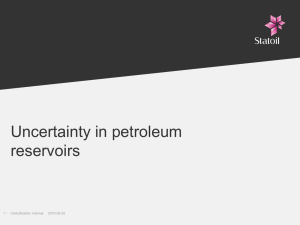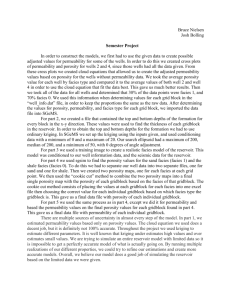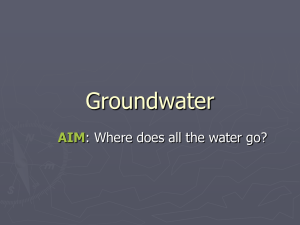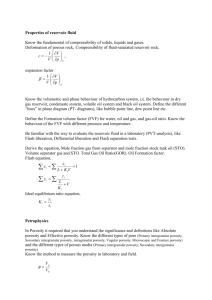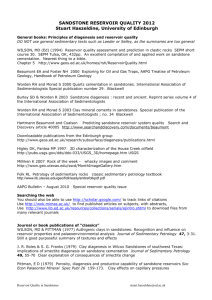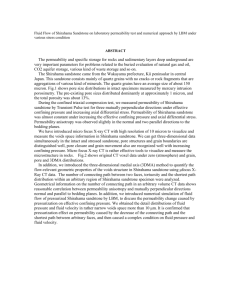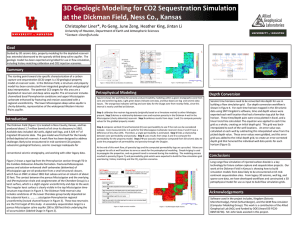Sandstone Reservoir Heterogenity
advertisement
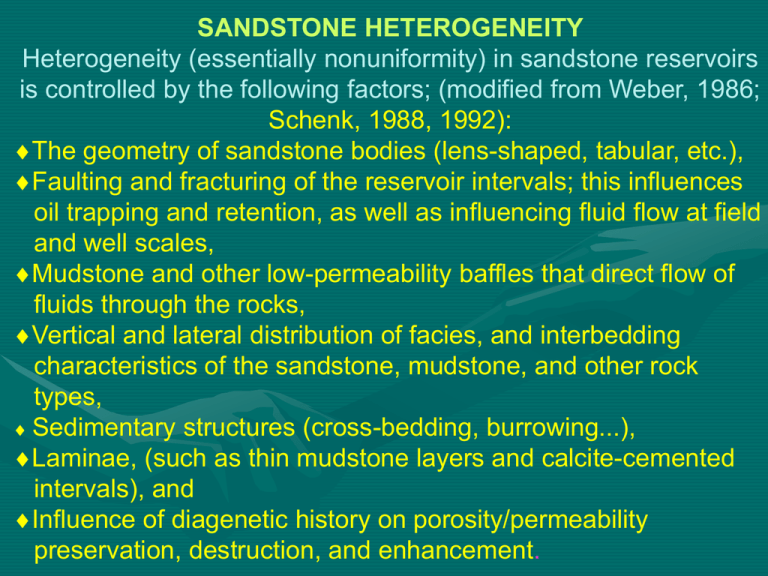
SANDSTONE HETEROGENEITY Heterogeneity (essentially nonuniformity) in sandstone reservoirs is controlled by the following factors; (modified from Weber, 1986; Schenk, 1988, 1992): The geometry of sandstone bodies (lens-shaped, tabular, etc.), Faulting and fracturing of the reservoir intervals; this influences oil trapping and retention, as well as influencing fluid flow at field and well scales, Mudstone and other low-permeability baffles that direct flow of fluids through the rocks, Vertical and lateral distribution of facies, and interbedding characteristics of the sandstone, mudstone, and other rock types, Sedimentary structures (cross-bedding, burrowing...), Laminae, (such as thin mudstone layers and calcite-cemented intervals), and Influence of diagenetic history on porosity/permeability preservation, destruction, and enhancement. Reservoir quality sandstone is a function of sedimentologic and petrologic heterogeneity. Increase in porosity and permeability is tied to increase in depositional energy. This results from: Better grain sorting and associated decrease in amounts of fine-grained sediment within pore throats and spaces, Greater vertical and lateral communication between porous/permeable beds, Fewer and thinner mudstone layers and other permeability barriers, and Decrease in low-permeability calcite-cemented (mainly finegrained) sandstone. Diagenetic/petrologic/depositional processes strongly influence porosity and permeability destruction, preservation, and creation; these are of course critical to migration of oil into the field and its subsequent recovery. Geometry and interbedding behavior of reservoir and non-reservoir facies controls fluid flow at well and bedform scales. Permeability boundaries to fluid flow occur at microscopic through megascopic scales. Connectivity and vertical- and lateral-continuity of oil-productive facies influences how much petroleum can be produced both from individual wells and from the field. FLOW-UNIT RATING, PERMEABILITY (mD), POROSITY (PERCENT), AND PETROLOGIC CHARACTERISTICS E. Trough- and planar cross-bedded fine- to medium-grained sandstone that represents the highest depositional energy and greatest reservoir potential. >15 mD, 10 to 22 percent G. While tabular, wavy-bedded, and ripple-laminated sandstones (flow unit G) near the tops of reservoir sand ridges may exhibit similarly high porosity and permeability values, fluid flow and other factors are different. G, 12 to 40 mD, 8 to 18 percent, F. Ripple-laminated, tabular, and wavy-bedded fine-grained sandstones that are commonly interbedded with thin trough-crossbedded fine- to medium-grained sandstones Interbedding of flow units E and G, and to a lesser extent F, results from highly variable depositional energy conditions across the field. F, 5 to 20 mD, 8 to 18 percent, P5. Ripple-laminated, tabular, and wavy-bedded very-fine and finegrained sandstones. Reservoir favorability is further decreased by the interbedded, thin, calcite-cemented sandstones, numerous mudstone drapes, and biologic reworking. P5, .01 to 2 mD, 1 to 13 percent, P6. Burrowed and bioturbated mudstone and very-fine-grained sandstones that bound reservoir sandstones. This flow unit contains very low porosity and permeability and forms updip and overlying reservoir seals. P6, .01 to 15 mD, 1 to 16 percent, P7. Thinly bedded mudstone and calcite-cemented, fine-grained sandstones comprise P6. These form permeability barriers that are laterally continuous and separate upper and lower sand ridges, primarily ridges 1 and 2. P6 thickness is as much as 10 ft (3.5 m), but is generally less than 5 ft (1.5 m). P7, .01 to 19 mD, 1 to 16 percent, This low-porosity and low-permeability unit is composed of thin mudstones and calcite- and quartz-cemented sandstones. Thickness ranges from inches to less than 5 ft (1.5 m). P7 forms numerous discontinuous permeability baffles. Megascopic and Macroscopic (Field and Well) Scales sandstone heterogeneity -------results mainly from the following factors. The lens shape of the reservoir interval (figure 19), which has different fluid flow and petroleum production characteristics than, for example, a tabular reservoir. -----" sandstone production is concentrated along the axes of the field, and from the thickest intervals of stacked reservoir sandstones. The lensate form of the reservoir is distinct from the lens and tabular forms of individual reservoir sandstones that comprise the reservoir intervals. Each of these has its porosity/permeability/fluid flow-characteristics. The reservoir sandstone intervals (green, yellow, orange, and red) are essentially lens shaped. These are composed of many thin, laterally discontinuous, interbedded sandstone and mudstone beds. The sandstone intervals pinch out along the eastern (seaward) margin and grade into non-reservoir (blue) and lower quality reservoir facies along the western field boundary. Datum is the basal disconformity (erosional surface). This 3-D distribution of porosity slice (figure 19) reveals; The lower (1) sand ridge exhibits the greatest porosity close to the seaward (eastern) margin of the field with porosity decreasing westward, The upper (2) sand ridge is composed of two separate sandstone units, close to the eastern and the western field margins. These sandstone bodies separate further and pinch out entirely a few slices to the north, and Lowest porosity intervals are basal and landward (westward) facies of most sandstone bodies. These low-porosity intervals compartmentalize the reservoir in this view and across much of the field. What this means is, in order to produce oil from both sandstones, both intervals must be perforated. Macroscopic and Microscopic (Well and Sample) Scales Processes of porosity and permeability destruction from pervasive early cementation by calcite and (or) quartz, precipitation of clays, or by compaction are shown in figure 22 (cmts4sm.gif). ----sandstone primary and secondary porosity, and microporosity are shown on the following thin-section photomicrograph and SEM images. Pore spaces in all photomicrographs are filled with blue epoxy. Ferroan carbonates are stained blue (ferroan dolomite has dark blue crystals). Unless otherwise indicated, photomicrographs are with transmitted light. Scale bars on most images are 0.1 mm. Porosity in the thin section is partially decreased by early diagenetic cementation of quartz grains. The original rounded quartz grains are outlined by green-colored chlorite crystals. Early diagenetic cementation preserves porosity and permeability in the Sussex "B" sandstone by supporting the grain framework and decreasing porosity loss through compaction. Figure 23. A. Thin-section photomicrograph from 8,012 ft (2,442 m) depth, No. 1 Empire Federal "C" well (fdissols.gif). Dissolution of the large feldspar (F) grain, located near the center of the image, results in secondary porosity. The crystal structure and outline of the feldspar grain is still apparent. Primary (depositional) porosity borders this and other grains. Quartz grains are labeled Q. Microporosity results primarily from breakdown of feldspar into kaolinite (K on large-scale view) and other clay minerals; this causes a mottled appearance of the blue epoxy that fills pore spaces. MS is a mudstone clast. Scale bar is 0.1 mm. The full-scale 1.5 MB thin-section photomicrograph of feldspar dissolution B. Scanning electron microscope (SEM) image of kaolinite shows partings between booklets and minor amounts of "wispy" illite-smectite clay from the No. 1-23 House Creek Federal well (semkaosm.gif). Scale bar, below the illite-smectite label, is 4 micrometers. The 656 KB SEM full-scale image of kaolinite booklets
